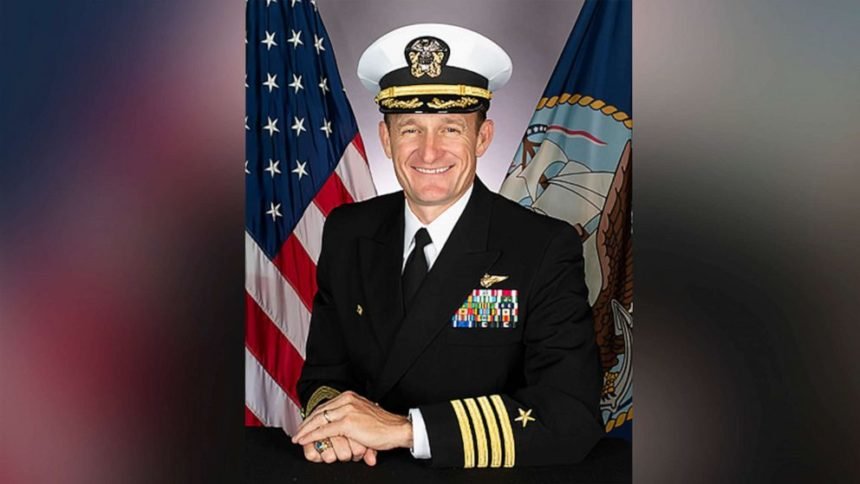Navy upholds firing of USS Theodore Roosevelt captain who pleaded for help with virus

WASHINGTON, DC — In a major reversal, the U.S. Navy has decided to fire the captain of the USS Theodore Roosevelt aircraft carrier who warned about the spread of the coronavirus pandemic aboard his ship.
The Navy’s actions were expected to be announced at a Pentagon briefing that will take place later on Friday.
It’s a decision that comes after the findings of a preliminary investigation recommended Capt. Brett Crozier be reinstated.
But the Navy’s top leaders have now decided not to reinstate Crozier and the admiral in his direct chain of command will be held accountable as well over their handling of the outbreak aboard the aircraft carrier.
The outbreak aboard the ship sidelined the Roosevelt in Guam for more than two months and left a quarter of the 5,000 sailors aboard infected with the virus, including one who died.
After reviewing a broader investigation into the circumstances involving the spread of the virus aboard the ship and the chain of command’s response, Adm. Mike Gilday, the chief of naval operations, decided that Crozier should not be reinstated and that Rear Adm. Stuart Baker, his direct supervisor as the carrier’s strike group commander, should be held accountable and that his promotion to two-star admiral be placed on hold,.
That investigation revealed that Crozier made poor decisions in response to the outbreak. He will not receive any other punitive action.
The decision to uphold Crozier’s being relieved of command is a dramatic reversal from Gilday’s earlier recommendation in late April to take the unprecedented step of reinstating him to his command.
Crozier was relieved of command in March shortly after the carrier had arrived in Guam after the first cases of the coronavirus were discovered aboard the ship. Crozier wrote and then sent a letter — allegedly around his chain of command — asking for more Navy assistance to stem an outbreak on his ship.
The letter was eventually leaked and published by a newspaper. The resulting controversy led to a series of events that resulted in Crozier’s firing by Thomas Modly, the acting Secretary of the Navy. Modly resigned days later, after he made disparaging remarks about Crozier to the ship’s crew, labeling him as “too stupid or too naive” to think that the letter would not have become public.
In late April, after receiving the results of an initial review into the matter, Gilday recommended reinstating Crozier to command of his ship. But Defense Secretary Mark Esper requested that the Navy undertake a broader review that would look at not just why Crozier had chosen to write the letter, but also look at the actions and decisions made by the chain of command in response to the Covid-19 outbreak aboard the ship.
In his letter, Crozier had requested that 10% of the crew remain aboard the carrier to carry out essential services and that the majority should be placed in quarantine on Guam. In the end those proposed steps were similar to what the Navy carried out as the ship remained in Guam for 10 weeks while the ship was disinfected and the ship’s crew was quarantined and recovered from the virus.
Despite those efforts, 1,273 sailors among the 4,865 aboard contracted the virus, equal to 26% of the crew, including the one who died from complications from the virus.
In the wake of the outbreaks aboard the Roosevelt and the USS Kidd, a guided-missile destroyer, the Navy implemented new health and safety procedures to prevent outbreaks among the 90 Navy ships currently at sea.
That includes regular testing, the wearing of masks and social distancing are practiced in all Navy units, but a main focus is on ships at sea where close quarters can facilitate a quick spread of the virus among the crew.
Before Navy ships head out on a deployment, crews are tested and quarantined so that no one will bring the virus aboard a ship. To ensure that the ships remain a “Covid-free bubble,” the Navy is now developing new rules for where its ships can make ports of call.
The Navy will only allow ports of call at a select number of Navy bases around the world that will serve as “safe havens.”
The carrier left Guam in early June to resume its deployment to the western Pacific, though it remains unclear when the ship will eventually return to its homeport of San Diego.
On Thursday, two of the ship’s aviators ejected safely from their F/A-18F fighter after it crashed in the Philippine Sea.


